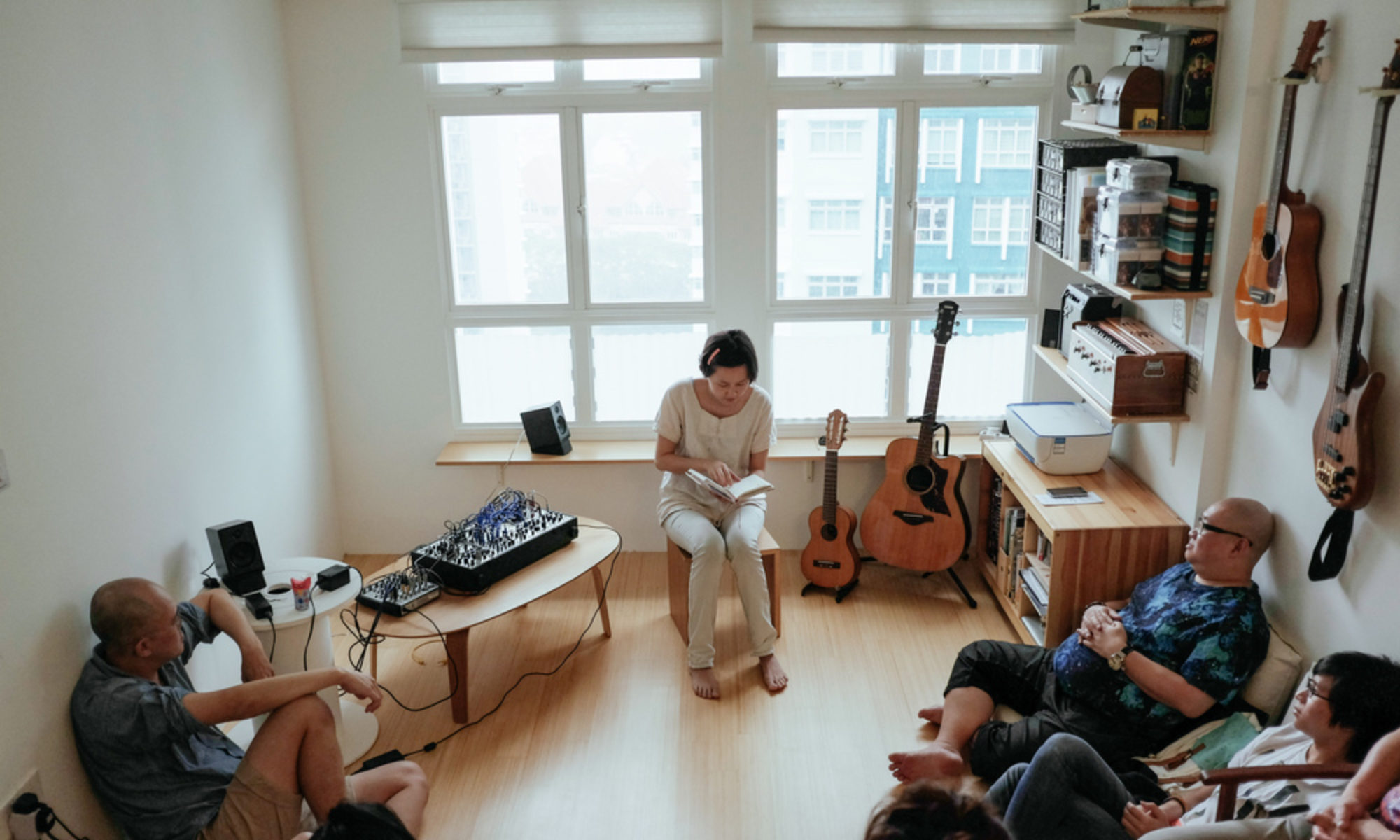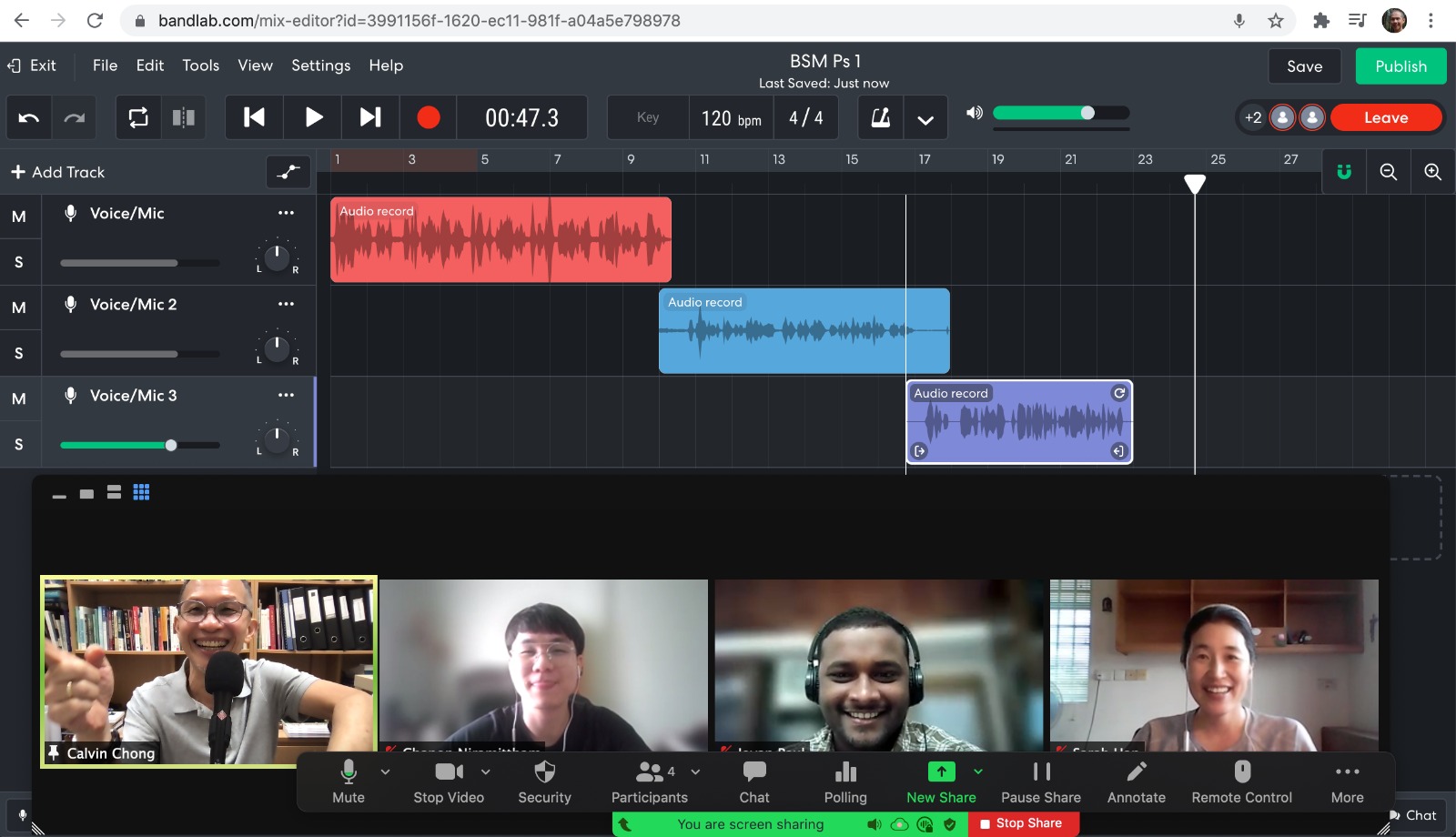Summary
In this essay, one of our Groupers, Dr. Calvin Chong, shares about his journey of exploring fresh missional, pastoral, and educational possibilities through digital technology and the arts with various communities.
He shares 6 examples for our consideration: i. collaborative music making with seniors; ii. music ministry amongst Thai youth; iii. digital music production class with Myanmese refugee youths; iv. online music therapy; v. sonic arts with migrant workers; vi. performing Bible texts.
Calvin is an Associate Professor of Practical Theology at Singapore Bible College, Board member of the migrant NGO HealthServe, and a leader at Covenant Community Methodist church.
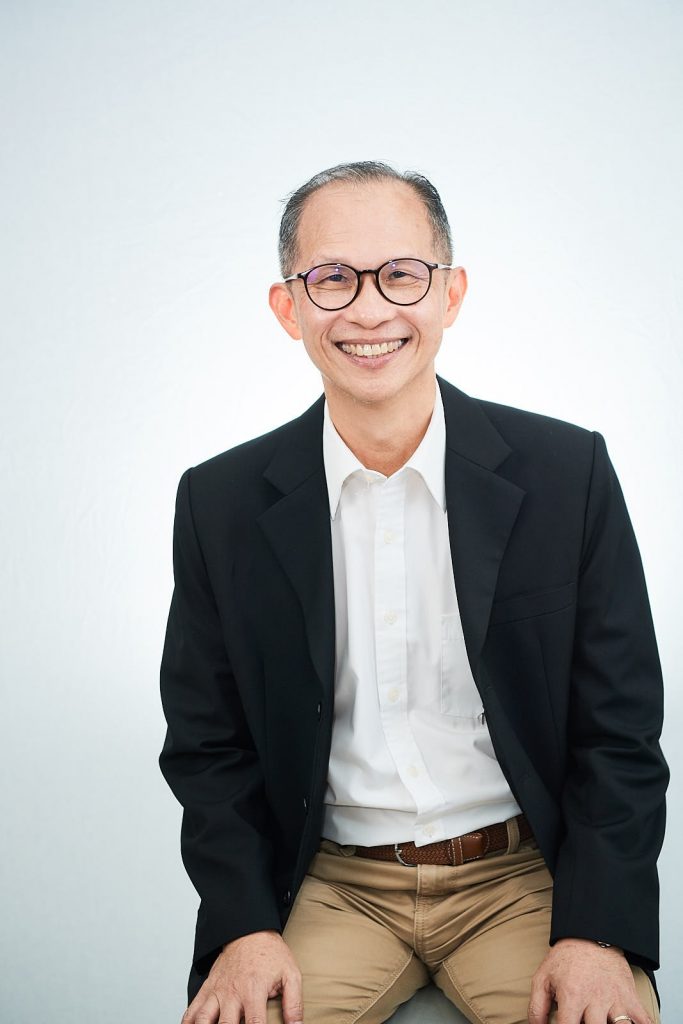
Church Music Ministries: Alive or Asleep?
One of major setbacks for churches in COVID pandemic lockdown has been the loss of our ability to participate in in-person congregational worship. The restrictions that churches have had to endure over the last year-and-a-half has resulted in church bands and choirs becoming less active. This loss of momentum has seen our musicians and their equipment now become rusty or dusty.
The same has been true for church groups conducting musical outreaches into the community. Whether to hospices, elderly homes, and shelters, or through face-to-face classes with underprivileged youth, domestic workers or migrant workers, many outreach initiatives have now come to a standstill.
This sad, sleepy state of music ministry’s contribution to the life of the church might strike a chord with many, but it tells only half the story. That’s because early adopters of digital music technologies have long been creating and recording music on their computers and mobile devices. This group was already exploring music ministry’s horizons of possibilities and were able to help fill the content gaps for weekly pre-recorded or live-streamed worship services.
With relative ease, they helped create backing tracks, home worship recordings, and even video collages of choirs and bands from their home studios. Late adopters picked up necessary skills and know-how to support various worship and outreach initiatives.
Far from having to stare blankly at a wall of uncertainty, this ministry discovered new impetus and energy. From the contribution of this team, congregation members in lockdown continued to be provided weekly opportunities to exalt, encounter, and respond to God in praise and worship. Opportunities for praise leaders, instrumentalists, and choir members to contribute remain available. Innovation and adaptation is keeping the ministry alive. The flame is kept burning – ministry members are not rusty and their equipment not dusty.
My Journey into the World of Digital Music
The impetus for my journey into the world of digital music can be described in four words – “The tuning lacks precision!” I had at that point of my life become very fascinated by ethnic flutes from around the world and sought not just to collect them, but also to play them. The more I played these largely handcrafted instruments, the more I became conscious of how imprecisely tuned folk instruments can be.
I thus acquired an electronic flute to stay in pitch. The technical term for this class of electronic instruments is “midi windcontroller.” The immediate hiccup that I experienced with my first midi windcontroller was that it wasn’t an instrument which had its own built-in sounds. The instrument had to be paired with computer software (also known as Digital Work Stations or DAWs) from which sounds were derived. Having successfully overcome that first challenge and listening to my first sounds played, I also learned that you can record the sounds and melodies produced in your DAW.
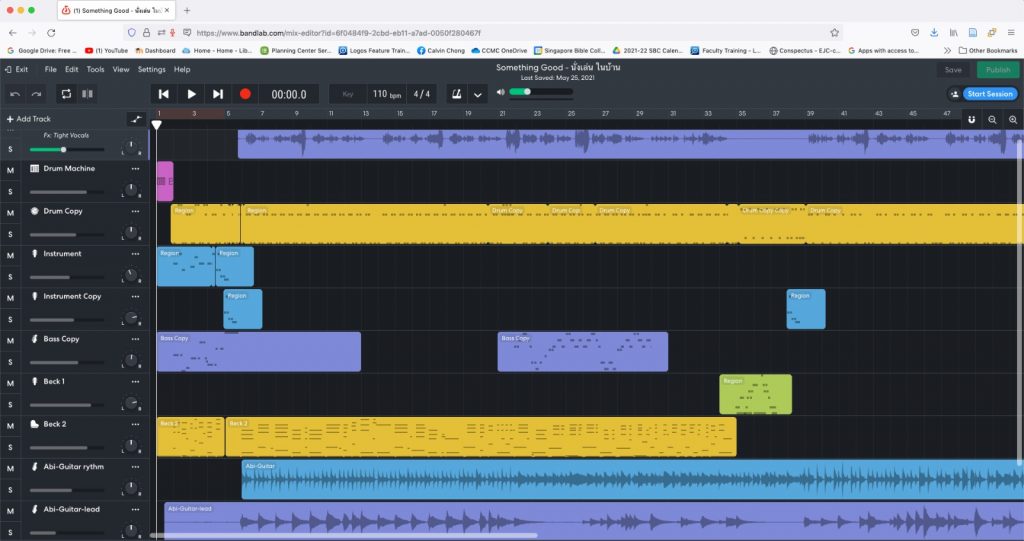
This understanding of how instruments can be paired with software and how melodies can be captured as musical tracks in DAWs spawned many other discoveries. YouTube opened my eyes to an amazing range of digital instruments you can hook up to your DAW.
Besides wind controllers, musicians were using keyboards, guitars, violins, harmonicas, accordions, drum pads, and other midi controllers to produce a very wide range of instrument sounds. Sounds generated didn’t have to match what the instruments looked like. In skilful hands, midi keyboards could be used to produce the music of an entire orchestra. Midi harmonicas could sound like violas. Midi guitars could play like a very nice Steinway. Midi saxophones could imitate the haunting sounds of the Chinese erhu quite precisely.
With my midi windcontroller, I explored all my favourite instrument sounds – from the oboe to the cello to the haunting sounds of the Armenian duduk! What impressed me was that urban, orchestral, and exotic ethnic sounds all can be produced by any of these instruments! And the nicest thing for me is that everything produced remained in tune!
Alongside the digital music discovery journey also began the digital music creation journey. That involved using music creation tools like loops and plug-ins, recording with proper equipment, auditioning sounds and instruments, and learning about mixing tracks. Along the way, I also discovered multiple repositories of free, downloadable hymn tracks which could be dragged into my DAW. With a few quick moves, karaoke hymn tracks would be ready for use. All that was needed were choir voices or instrumental leads!
This excursion into the world of digital music brought awareness of a very rich, thriving culture of music creation and consumption. I had entered a realm which was already populated by songwriters, performers, producers, hobbyists, educators, therapists. Together with them, I had found my way into a space where tools, workflows, and intuitions were quite different from that found in traditional settings.
A Pastoral and Missional Frontier?
For years, the church has explored avenues of incorporating music and the arts in outreach and missions. This is already an area of interest I have explored extensively. For this, I have read many books and spent many hours listening to the stories of practitioners. I have even taught a whole course on it at Singapore Bible College and supervised many incubator projects proposed by students.
Observations and experiences at the digital frontier however raised for me questions about fresh missional, pastoral, and educational possibilities. Having ventured into the world of digital music creation and tinkered with many toys in this sonic playground, something in me was triggered to explore and experiment.
Given that a lot of my involvement in music lies in music education, community outreach, and mental wellness support, the initial ministry projects were focused on collaborative music creation on a Digital Audio Workstation (DAW) hosted in the cloud. Most DAWS reside in your computer. The one I used was different because it is web-based and free to use.
This online platform, named Bandlab, offered opportunity to gather different groups at a common digital space to make music together. And all this done in real-time and remotely from different parts of the country or the world.
Below I share six project ideas which have been initiated or which hold out promising ministry potential.
i) Collaborative Music Making with Ukulele Group Seniors
I lead a weekly Monday evening ukulele group. Currently meeting on Zoom for a year-and-a-half, the group comprises largely of seniors from different churches in Singapore and Penang. The group is eclectic – we have churched, unchurched, Protestant believers, Roman Catholic believers, as well as non-believers in our midst.
In the spirit of learning new skills, I offered to teach the group how to record ukulele and vocal tracks into BandLab. The early sessions were focused on simple tech challenges like how to create a BandLab account, how to share Zoom screen, and questions about microphone settings. That the challenges for some of them were overwhelming and ran deep reflected in how answers to basic questions had to be repeated over and over. In the end, half the initial group dropped out.
One helpful move was when one of the members hosted four of us at his home. There we were able to address the technical issues, record a song together, and enjoy curry puff and nyonya kueh together!
But the real joy in the group continues to be how we are able to record songs from our remote locations. Indeed, the first successful group recording was done from two countries. After one of the participants from Penang had completed recording the vocals for “Jesus Saves” (to the tune of “Pearly Shells”), I then added the ukulele track to her track. Imagine the wonder and amazement of all present in the Zoom session as we witness with our ears and our eyes the possibilities of co-creation in spite of our physical distance!
This group continues to meet. Our goal is to make more tracks together but my strong encouragement to them is to use music to connect family members together–especially if their children and grandchildren are overseas. Creating shared experiences and shared memories strengthens families. How much better if the cool grandpa or the cool grandma is initiating efforts using cool tools!
ii) Thai Folk Song Project
As the seniors project was taking off, I reached out to a young Thai student from Singapore Bible College who is in her twenties. I shared the idea of a collaborative DAW with her and then spent half an hour showing her the features found in BandLab. I then left her a challenge to record a song with her brother who is based in Chiangmai.
Unlike the seniors who struggled with tech questions and challenges, their project was completed in a week. She and her brother had decided to do a cover of a song produced by a popular Thai “uncle band.” In a short time, they went on to record vocals, drums, keyboard, melodica, guitar, and bass parts.
As a follow-up, I did a Zoom interview of both of them to ask questions about their process of recording as well as the ministry possibilities that BandLab offered. The answer about process revealed details unknown to me. It turned out that the song was co-created from three physical locations.
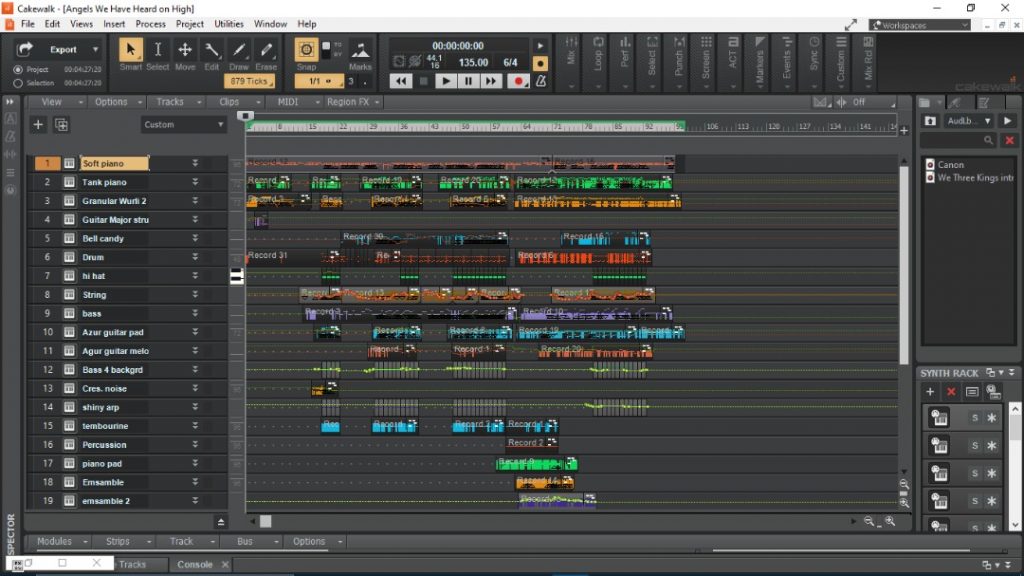
My student was in Singapore and her brother was in Chiang Mai. He reached out to his girlfriend located in Bangkok who added vocals and keyboard tracks. The interview also revealed that my Thai student had also roped in her Filipino roommate who recorded guitar parts in the project.
It was the answers about ministry possibilities however that caused my heart to beat really fast. The siblings shared in great detail about being able to support under-resourced churches by helping them to create worship tracks. They also shared about how pastors with interest and know-how can connect deeply with segments of their congregation members, about how intergenerational connections can be built through online music creation, about how this can be used as a training and recruitment platform for the AV team, about how worshiping with knowledge of the music behind the lyrics can be promoted, etc.
But the one they shared that caught my attention more than any other was about how Thai youth love music and how the non-Christian ones amongst them go to church to jam and to learn. Going to church however is often perceived as being anti-Thai because parents expect their children to be at the local temple, not at the local church.
Meeting with them online and connecting over music making would sidestep parental objections and allow the work of outreach and discipleship to carry on in a creative, caring environment! Woohoo!
iii) Digital Music Production Class with Myanmese Refugee Youth
One of the joys in life I have is knowing that there are committed Christians reaching out to the many refugees populations in Malaysia. One such group, the Ruth Education Centre (REC) in Klang, Malaysia serves Myanmese refugees by offering schooling to their youth.
What began as a casual acquaintance with REC developed into an opportunity to introduce the Irish tinwhistle to twenty of them in 2017. Then in June 2021, I was able to offer a two week class entitled “Becoming a Digital Music Creator, Storyteller, and Educator” to thirteen of the youth and young adults from REC.
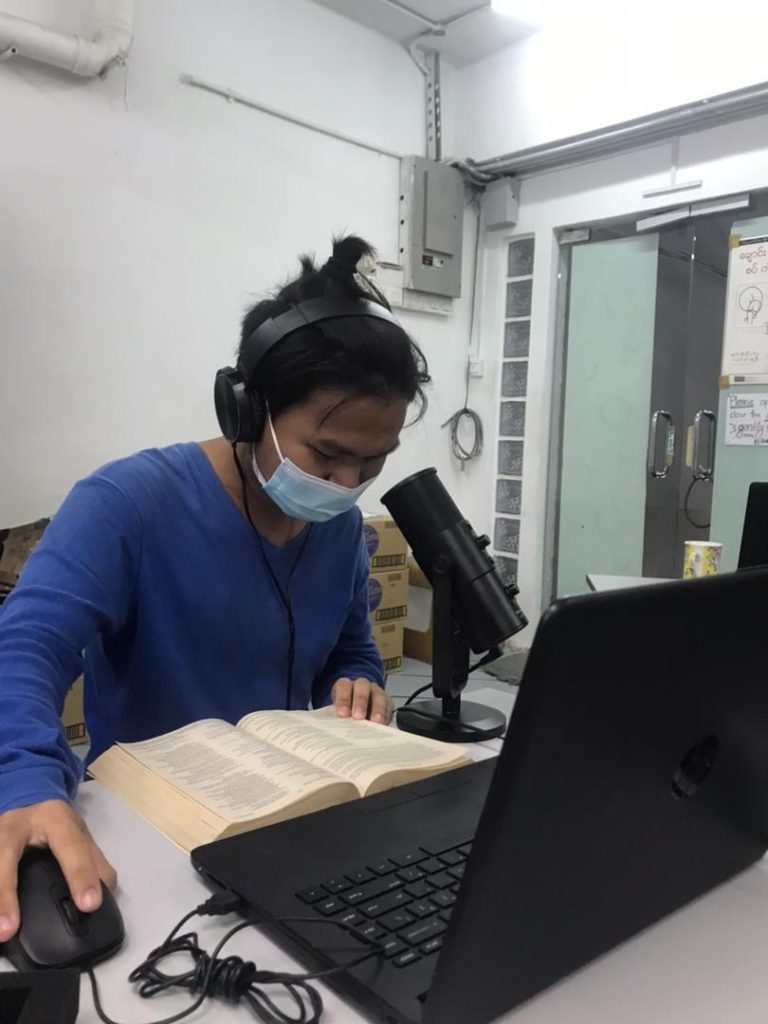
For that, I created a whole website to support their learning and raised funds from my seniors ukulele group to purchase equipment for them. Together with my classes and the practice exercises they had to work on, I also invited industry experts to share on digital music production and mixing skills.
The thinking behind this initiative was to take a more developmental approach to serving refugee populations. Too often, solutions offered to this demographic serve immediate needs but don’t help them to break out of their economic traps. The class was designed to expose the youth to 21stC digital literacies and competencies. It was offered to stimulate educational imagination and expand economic horizons! And this being a Christian school, it also gave the youth an opportunity to pay forward and in turn, to be a blessing to others!
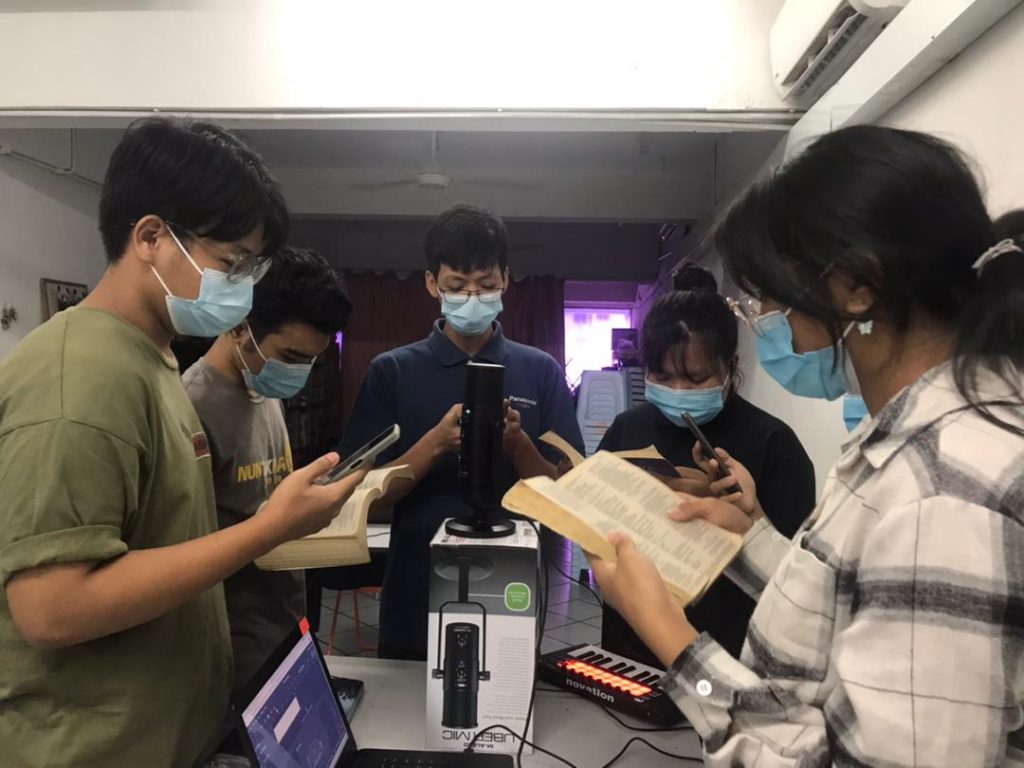
iv) Exploring Online Music Therapy
Having participated in many different arts events either as an observer, performer or a facilitator, I have come to the conclusion that freeplay as well as facilitated arts sessions can lead to profound therapeutic outcomes. Whether it be through community drama, clay art sessions, community drumming, and art jams, they hold potential for transforming mindsets and uplifting spirits!
How about use of digital tools and platforms for music therapy? To find my answer, I reached out to a trained music therapist with my question. The effort yielded fascinating answers. Yes, music therapists have long used audio recording software with their clients.
Amongst the stories she shared included one of recording the heartbeat of a prematurely born baby with neonatal complications. She then invited both parents to sing to the rhythm of the heartbeat and provided the musical support to produce several lullaby tracks.
My contact also shared an article about the genesis of this music therapy idea. After reading it, I began to understand why the idea is meaningful to parents with babies who have a reduced chance of survival.
Sometimes, parents have found solace in listening to the recordings after the death of a child who couldn’t be saved.
Some parents have used these recordings at their funeral or celebration of life.
The other story she shared was about clients in hospice care requesting the music therapist to record their favourite songs in the final weeks of their lives. Some of these clients were too weak to sing the whole song and could only voice the last lines of each verse.
She was thus able to weave those recordings with recordings done by other members of the family to create keepsakes of the deceased after the client’s passing. What amazing and creative pre-loss care offered through legacy creation!
Just these two stories gleaned from the interview left me wondering about extended possibilities that come with inviting contributions by others separated by geographic distance. With music and words recorded into an accessible online DAW, how can significant others and invited guests offer tangible support to individuals facing vulnerable moments in life? Perhaps music therapists amongst us can help us with answers and possibilities!
v) Sonic Arts Project amongst Migrant Workers
If the nation under COVID pandemic lockdown is facing many mental health challenges, the migrant worker population in Singapore continues to experience mental health challenges in ways we could never imagine. Faced with fear and uncertainty about COVID-19 infection, job insecurity, inability to repay huge debts owed, safety of family members back home, and prolonged periods of confinement, stress levels amongst them are currently at very unhealthy levels.
Those involved with outreach work amongst migrant workers in Singapore tell us that “boots on the ground” is the most effective way to engage the brothers. However, the tight movement and access restrictions has forced deliberation of “virtual boots on the ground” engagement events and activities.
One of the ideas I am currently experimenting with is getting migrant workers to record sounds from their dormitories or workplace that represent the dirty, dangerous, demeaning and dreary world they live in. This could be the sound of the pile driver, the road drill, the lorry engine, the grass cutter motor, the security scanner, etc.
The sounds extracted from the mud of everyday life can be reinterpreted and woven into a tapestry of sonic art comprising songs, poetry, ethnic percussive rhythms, and other recorded sounds. Put together, they can help participants to express thoughts, shared experiences, lament, hope, and other emotions. As a meaning making activity with contributions from family members, members in their dormitory, and even with sympathetic local volunteers, it can also serve as a bonding activity between and across communities.
vi) Feeling the Message by Performing the Bible Text
The final project finds inspiration from the oral arts community where participants are invited to perform a text. Performing a text allows participants to go beyond merely reading the text silently as individuals. It allows a group to vocalize as well as listen to spoken renditions of the text.
Drawing inspiration from Readers’ Theatre (where performers are not pressured to memorize the text but invited to read with expression) and Speech Choirs (where choir members perform words, phrases, sentences and paragraphs of the text in unison, antiphonal recitation, echo, harmony, with sound effects, etc), participants familiarize themselves with the text as well as immerse themselves in the feeling of the text.
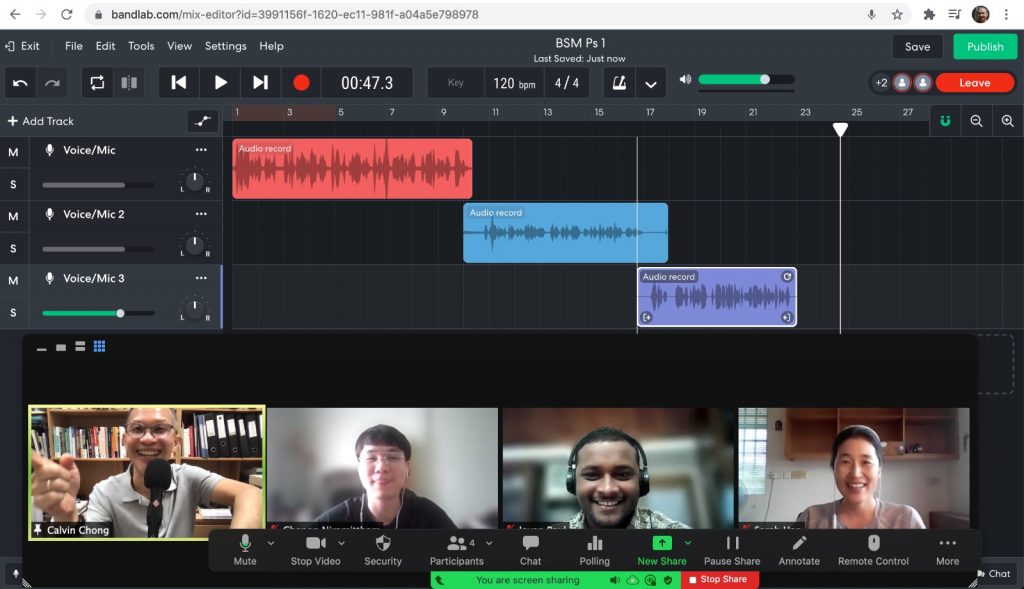
The experience of gathering to perform a text, working out roles, rehearsing for the performance, recording parts, and reviewing the completed production contributes powerfully to understanding in both head and heart. In addition, the group preparation and performance also translates into a very bonding and uplifting social experience.
One project that I have began work on relates to performing the Psalms. The different genres in the Book of Psalms capture a very broad range of psalmists’ emotions and responses to God, people, and circumstances. To explore these, students are invited to discover through performance not just literary elements used by psalmists but also emotional depth found in Hebrew poetic works. In addition, we also explore how to communicate both cognitive and emotional elements of specific Psalms to modern audiences!
Summary and Concluding Challenge
I introduced this article using the language of setback, stoppage and restriction experienced by church music ministries. I then moved on to describe a personal journey of discovery as I sought to explore possibilities with music technologies.
There remain many other music technology explorations and discoveries which I have not shared. The ones I have, however, flow from my interest in gathering people at free-to-access online platforms to learn new skills. There they can find music creation and audio recording tools to play with, to experiment together, and to co-create.
While not the only online platform available in the market, I featured one called BandLab and shared six projects which have either been completed, remain ongoing, or are underway. I share these projects as my way of directing the gaze of the church to an underexplored pastoral and missional frontier.
For me, sharing these possibilities for missions and ministry in the digital music world is likened to starting a sentence and then putting a comma after. If the story we write together begins with a sentence which helps to fuel our imagination and point at possibilities, then the paragraphs that follow can only thicken the plot and heighten the adventure.
What’s your part in this story? We’re dying to hear about it. Just don’t take too long to start because there are still too many gaps in our story!
If you’re keen to find out more about how to be involved in digital music missional projects such as those above, feel free to email Calvin at calchong[at]sbc.edu.sg.
7 September 2021
